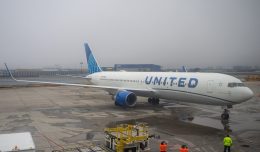Southwest Airlines finished 2009 having boarded over 101 million passengers, finishing first among U.S. carriers for the third consecutive year. American Airlines finished a distant second with a total of 85 million passengers, but led the international category.
The annual report published Monday by the Bureau of Transportation Statistics (BTS) revealed that 42.7 million fewer passengers took to American skies in 2009, representing a 5.3% decrease compared to the prior year and an 8.2% drop from 2007.
Atlanta-Hartsfield Airport (ATL) was the nation’s busiest in terms of total passengers served, followed by Chicago O’Hare (ORD) and Los Angeles International (LAX)
John F. Kennedy Airport (JFK) in New York retained its title as the country’s busiest international gateway, while Miami (MIA) jumped Los Angeles for the #2 spot from last year. LAX finished third.
Despite the decline in demand, the BTS report indicates that airlines did a good job of chopping capacity, managing to increase overall load factor by 0.5%. About 710,000 fewer flights took off in 2009, a drop of 6.6%.
United Airlines lost the most passengers of the top 10 airlines, suffering an 11.2% drop. (Northwest’s larger drop is due partially to its merger with Delta.) Thanks to expansion in new markets, JetBlue and SkyWest actually gained passengers over 2008, while Southwest suffered only a 0.6% loss.
For more details on the report, check out the sortable data below:
Table 1: Scheduled Domestic and International Airline Travel on U.S. and Foreign Airlines*
[table id=8 /]
Source: Bureau of Transportation Statistics, T-100 Market and Segment
* Includes U.S. carrier scheduled domestic and international service and foreign carrier scheduled international service to and from the United States . For U.S. carrier domestic and international service data for 2009, see the BTS December air traffic press release
** Change in load factor points
***The average non-stop distance flown per departure in miles
**** The average distance flown per passenger in miles
Note: Percent changes based on numbers prior to rounding.
Table 1A. Passengers on U.S. Carriers and on Foreign Carriers’ U.S. Flights 2008-2009
Passenger numbers in millions (000,000)
[table id=9 /]
Source: Bureau of Transportation Statistics, T-100 Market
Table 2. Scheduled Domestic and International Enplanements by Month on U.S. and Foreign Airlines*
Passenger numbers in millions (000,000)
[table id=10 /]
Source: Bureau of Transportation Statistics, T-100 Market
* Includes U.S. carrier scheduled domestic and international service and foreign carrier scheduled international service to and from the United States . For U.S. carrier domestic and international service data for 2009, see the BTS December air traffic press release
Note: Percent changes based on numbers prior to rounding.
Table 3. Top 10 Airlines, ranked by January-December 2009 Scheduled Domestic and International Enplanements*
Passenger numbers in millions (000,000)
[table id=11 /]
Source: Bureau of Transportation Statistics, T-100 Market
* Includes U.S. carrier scheduled domestic and international service and foreign carrier scheduled international service to and from the United States . For U.S. carrier domestic and international service data for 2009, see the BTS December air traffic press release
Note: Percent changes based on numbers prior to rounding.
Table 4. Top 10 Airports ranked by January-December 2009 Scheduled Domestic and International Enplanements on U.S. and Foreign Airlines*
Passenger numbers in millions (000,000)
[table id=12 /]
Source: Bureau of Transportation Statistics, T-100 Market
* Includes U.S. carrier scheduled domestic and international service and foreign carrier scheduled international service to and from the United States . For U.S. carrier domestic and international service data for 2009, see the BTS December air traffic press release
Note: Percent changes based on numbers prior to rounding.
Table 5. International Scheduled Airline Travel on U.S. and Foreign Airlines*
[table id=13 /]
Source: Bureau of Transportation Statistics, T-100 International Market and Segment
* Includes U.S. carrier scheduled international service and foreign carrier scheduled international service to and from the United States . For U.S. carrier scheduled international service data for 2009, see the BTS December air traffic press release
** Change in load factor points
*** The average non-stop distance flown per departure in miles
**** The average distance flown per passenger in miles
Note: Percent changes based on numbers prior to rounding.
Table 6. International Scheduled Enplanements by Month on U.S. and Foreign Airlines*
Passenger numbers in millions (000,000)
[table id=14 /]
Source: Bureau of Transportation Statistics, T-100 International Market
* Includes U.S. carrier scheduled international service and foreign carrier scheduled international service to and from the United States . For U.S. carrier scheduled international service data for 2009, see the BTS December air traffic press release
Note: Percent changes based on numbers prior to rounding.
Table 7. Top 10 Airlines, ranked by January-December 2009 International Scheduled Enplanements*
Passenger numbers in thousands (000)
[table id=15 /]
Source: Bureau of Transportation Statistics, T-100 International Market
* Includes U.S. carrier scheduled international service and foreign carrier scheduled international service to and from the United States . For U.S. carrier scheduled international service data for 2009, see the BTS December air traffic press release
Note: Percent changes based on numbers prior to rounding.
Table 8. Top 10 Airports ranked by January-December 2009 International Scheduled Enplanements on U.S. and Foreign Airlines*
Passenger numbers in thousands (000)
[table id=16 /]
Source: Bureau of Transportation Statistics, T-100 International Market
* Includes U.S. carrier scheduled international service and foreign carrier scheduled international service to and from the United States. For U.S. carrier scheduled international service data for 2009, see the BTS December air traffic press release
Note: Percent changes based on numbers prior to rounding.







